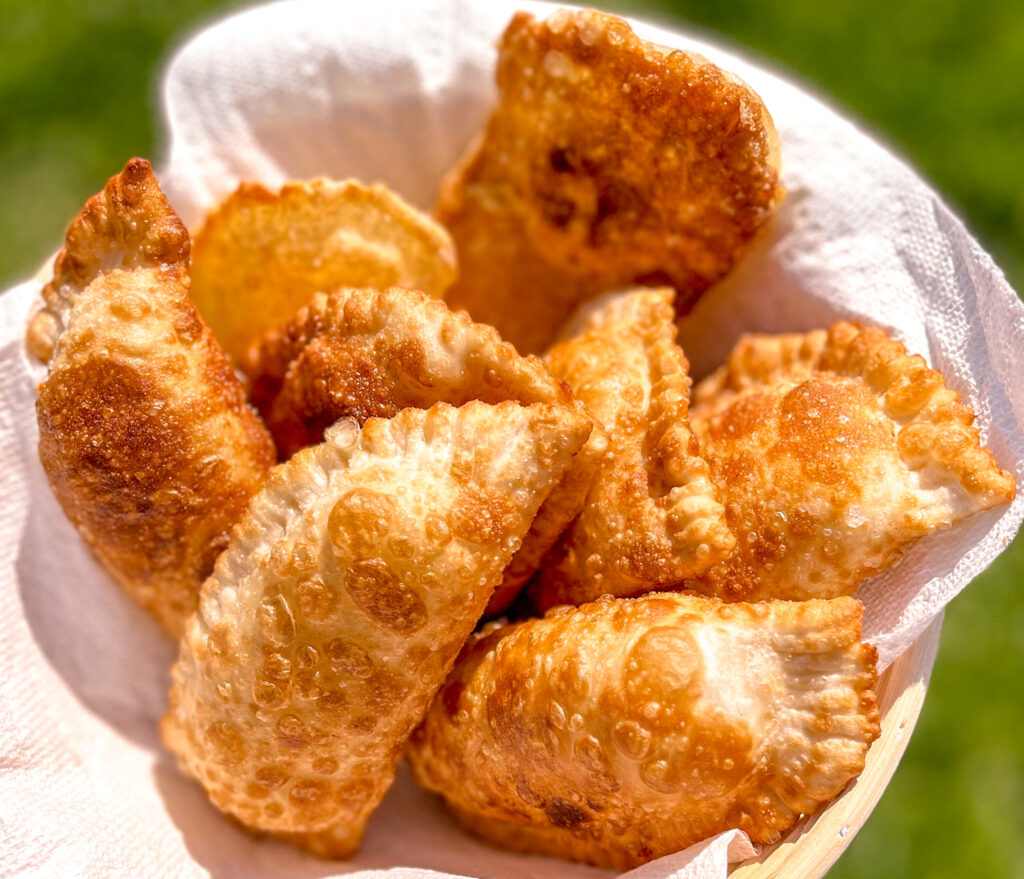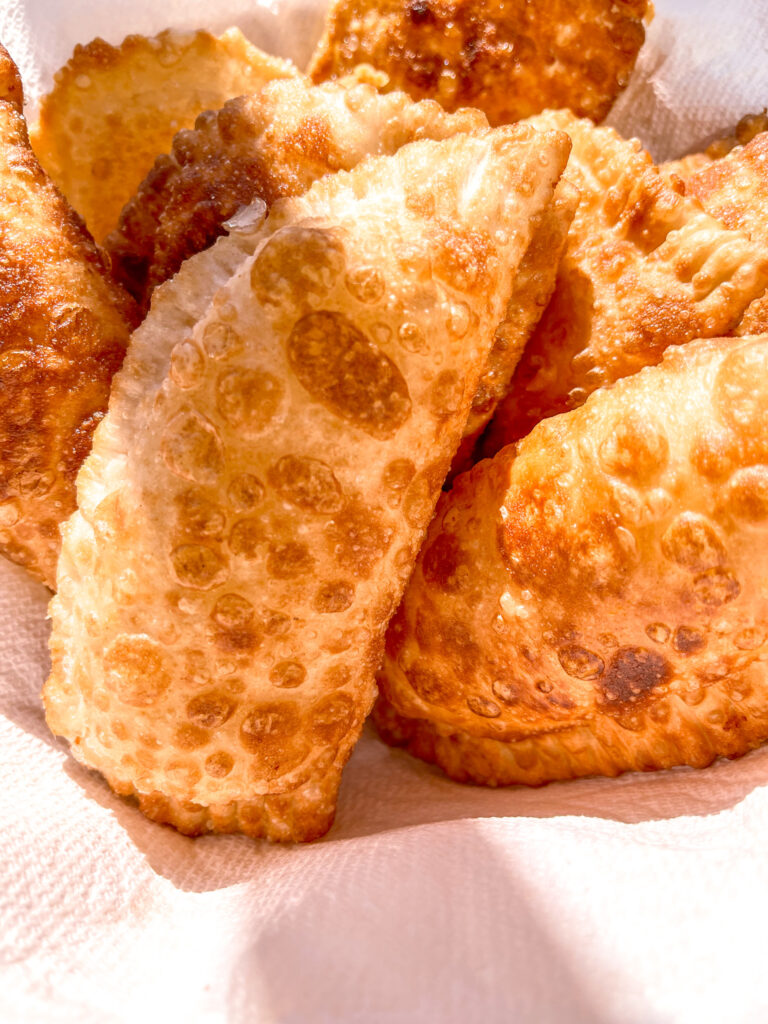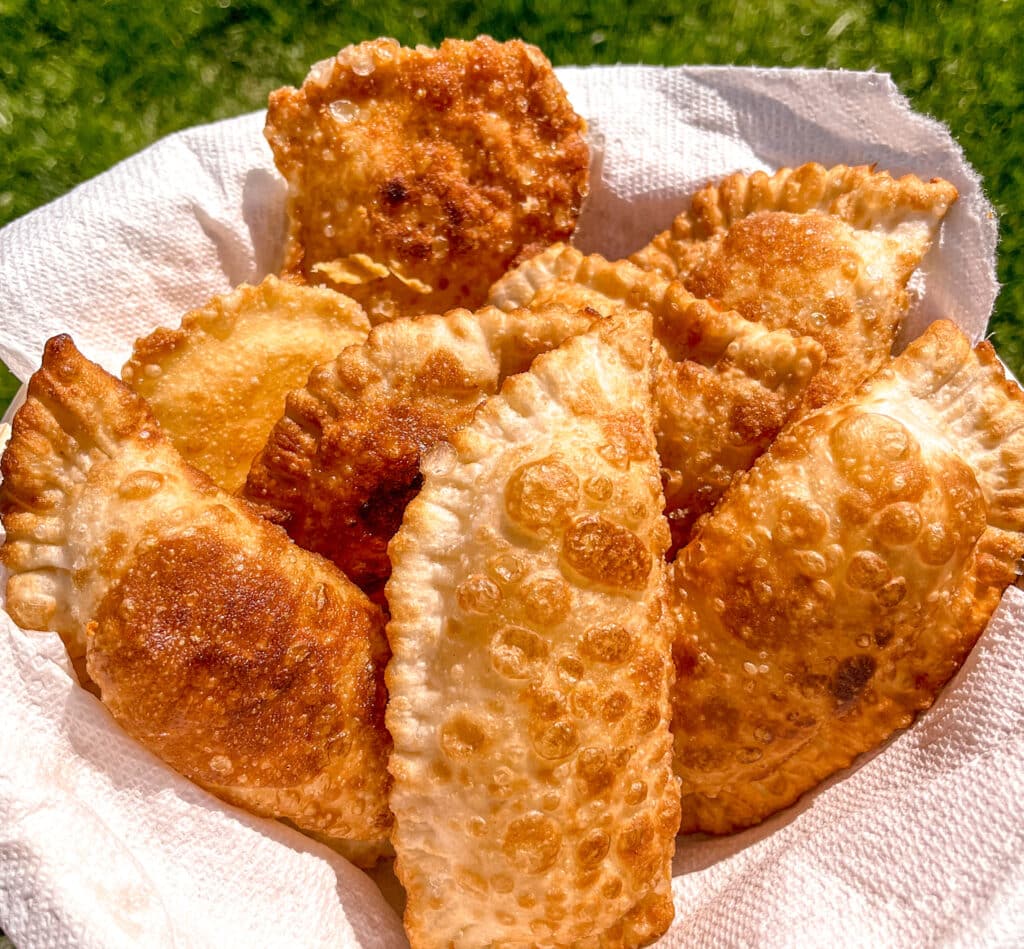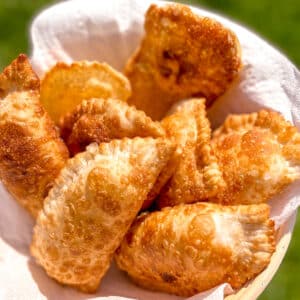When I was a kid, my grandma used to go to mass every Sunday. And on her way out, without fail, she’d stop and buy herself an Brazilian Pastel—crispy, golden, and stuffed with something delicious. If I happened to be with her, she’d buy me one too. That was always a treat.

Table of Contents:
2.Other Classic Brazilian Recipes to Try
5.How to Make Pastel – Overview

What is Pastel?
Pastel, in case you’ve never had one, is a deep-fried pastry that’s usually filled with things like ground beef, melty cheese, shrimp or heart of palm. Kind of like an empanada, but thinner, crispier, and uniquely Brazilian.
Most people think of them as fair food—and that’s totally fair (no pun intended). In Brazil, you’ll find them at street markets, beach stands, or even served as bar snacks. But for me, I always associate pastel with those Sunday mornings and the walk out of church.
Other Classic Brazilian Recipes to Try:
If you love cozy Brazilian street food like this, you might also like my recipes for Coxinhas and Cheese Bread . Two other crowd pleasing Brazilian appetizers. Some other great Brazilian recipes to try are:
Brazilian Chicken Pot Pie, Bakery Worthy Brigadeiro Cake, Carrot Cake with Brigadeiro, and you can even check out this page dedicated to Authentic Brazilian Desserts.
Funny enough, my grandma never made them at home. She didn’t need to! In Brazil, you can buy the dough at the grocery store, so she’d just make the filling and fry them up if she ever felt like it. But most of the time, she’d just buy one fresh—hot and ready.
Since moving to Canada though, I had to learn how to make my own. No pastel stands outside church here. No store-bought dough either. So I figured it out myself—and honestly, it’s not hard once you get the hang of it.
So here it is—my go-to pastel recipe, with all the little tips I’ve picked up along the way to get that crispy, bubbly, street-fair-style shell at home. If you’ve been missing pastel, or just want to try making it for the first time, I’ve got you covered.
A Bit of History
Pastel is one of those things that feels so Brazilian, you’d think it had been around forever—but it actually has a pretty fascinating backstory.
Turns out, it was Japanese immigrants who brought the concept over in the early 1900s. They started selling fried snacks that looked a lot like pastel, especially in São Paulo. Then during World War II, many of them began running pastelarias (pastel shops) and would sometimes pass the food off as Chinese to avoid discrimination at the time. Over the years, their influence shaped what we now know and love as the classic Brazilian pastel.
These days, there are pastel contests at street fairs, gourmet pastel trucks, pastel with sugarcane juice combos, pastel with every filling under the sun…

🧾 Ingredients Overview
Here’s everything you’ll need to make the dough:
- All-purpose flour (plus more for dusting – see tips below)
- Warm Water
- Oil : any neutral flavored vegetable oil works.
- White vinegar (I used apple cider vinegar)
- Cachaça What is cachaça? It’s a Brazilian sugarcane spirit that helps make the dough blister up and stay “sequinho” (crispy and dry, not greasy). You can find it at the LCBO if you’re in Canada.
You can skip it, but your pastel might not be quite as crispy. I haven’t tried, but vodka might work as a substitute! - Salt: add as much as you like. my version isn’t very salty so if you want you can add an extra pinch.
- Cheese: Traditionally Mozzarella cheese is used. You can add as little or as much as it will fit (without tearing) into your pastel.
Can I purchase the dough instead of making it?
If you have access to a Brazilian grocery store near you, you can also attempt to buy the dough and then just fill it with your favorite fillings. If you wish to do that search for “massa de pastel” or “massa para pastel”. Sometimes I can find it at brazilianmarket.ca and they deliver!
🔧 How to Make It
This couldn’t be simpler:
- Mix all ingredients together until a dough forms. Knead for a couple minutes until smooth.
- Roll it out using a rolling pin or a pasta machine.
- Fill with your favorite filling, fold and seal the edges.
- Deep fry until golden and bubbly.
That’s it!
💡 Important Tips
- Flour amounts: Add your flour little by little just until the dough stops sticking to your hands. Don’t add too much! During rolling, dust with more flour as needed.
- Shaping the pastel:
- Rectangular: Most common at street fairs.
- Half-moon: What my grandma used to make at home with store-bought dough.
- If using a pasta machine, large rectangles can be tricky. I shape them roughly and trim with a pastry cutter if I want cleaner lines. Or, just make smaller rectangles.
- Dough thickness:
- With a rolling pin, go as thin as possible without tearing.
- With a pasta machine, I roll up to setting #4 on my KitchenAid attachment. I tried #5, and while it didn’t tear, it was harder to handle. Try and see what works for you!
- Keep dusting with flour every time the dough goes through the machine—this prevents sticking and tearing.
- Oil temperature: The oil should sizzle immediately when you drop in the pastel, but not burn it. Adjust heat as you go to keep that perfect golden color.
- Sealing: Brush the edges with a bit of water, fold the pastel, and press with a fork to crimp. This helps keep the filling from leaking out while frying.
❤️ Final Thoughts
Whether you’re craving a bit of nostalgia or just trying pastel for the first time, I hope this recipe brings you as much joy as it brings me. Let me know in the comments if you give it a try, or if you’d like to see different fillings—I’m happy to share more! Just let me know in the comments below.

Brazilian Pastel
Equipment
- rolling pin or pasta machine
Ingredients
For the Dough
- 400 g all-purpose flour plus more as needed
- 200 ml warm water
- 1 tablespoon oil
- 1 tablespoon white vinegar I use apple cider vinegar
- 1 tablespoon cachaça1 see notes
- 1 teaspoon salt or to taste
For the Filling
- 400 g mozzarella cheese shredded or sliced (or as much as you like)
Instructions
Make the Dough
- In a large bowl, mix together the warm water, oil, vinegar, cachaça, and salt. Start adding the flour gradually, mixing as you go. Keep adding flour little by little until the dough comes together and no longer sticks to your hands.400 g all-purpose flour, 200 ml warm water, 1 tablespoon oil, 1 tablespoon white vinegar, 1 tablespoon cachaça1, 1 teaspoon salt
- Cover and let it rest for about 30 minutes.
Roll and Fill
- Roll out the dough as thin as possible using a rolling pin or pasta machine (setting 4 on a KitchenAid, see notes).While you’re working, keep any dough you’re not handling wrapped in plastic wrap or inside a Ziplock bag to prevent it from drying out.
- Cut into rectangles or circles, fill with mozzarella cheese, and fold over.400 g mozzarella cheese
- Use a pastry brush seal the edges with water and press with a fork.
Fry
- Heat oil in a deep pan until hot but not smoking.
- Fry pastéis a few at a time until golden and bubbly, flipping once.
- Drain on paper towels. Serve hot!






Leave a Reply